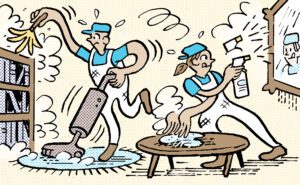It’s not your imagination – ad repetition is getting worse on streaming.
One big reason why is that many agencies use multiple demand-side platforms with different specialties. And as more streaming inventory goes programmatic, supply paths cross, and DSPs can only manage the media they’re buying.
For example, the Trade Desk can’t manage frequency caps for the portion of a client’s budget going to Google’s DV360 and vice versa.
To help give media buyers more control, TV measurement platform Innovid announced a new frequency management product on Wednesday that manages frequency caps across connected TV, mobile and desktop, including display and audio.
Harmony Frequency is the second product to come out of Innovid’s Harmony Initiative, which is a suite of tools designed to address the lingering pain points of CTV advertising. The first product, Harmony Direct, was dedicated to supply-path optimization.
Harmony Frequency is in beta, and Innovid expects to make it generally available later this year.
Figuring out frequency management
Meanwhile, overfrequency remains “the number one issue on CTV,” said Innovid CEO Zvika Netter.
Serving the same ad to the same person too many times is not only wasteful; it limits an advertiser’s ability to reach new and prospective customers.
Typically, managing reach and frequency across multiple DSPs means doing so at the publisher level. DSPs alone have a limited view into a publisher’s total ad avails, said Adam Roodman, SVP of product strategy and management at Yahoo DSP, which has been beta testing Innovid’s frequency product since early July.
But publisher-level campaign management is “not as sophisticated as having the actual audience segments,” Roodman said. It’s also far less efficient than giving media buyers access to ad exposure data from publishers and multiple DSPs in one place.
This is the problem that Innovid wants to address.
Innovid, which has an ad server and is integrated with most of the major TV programmers, matches its identity graph to impression delivery data from publishers and DSPs. Based on that information, Innovid can tell buyers which households in their target audience are overexposed or underexposed so they can move spend accordingly. A brand, for example, might choose to serve more impressions to a household that has only seen an ad once, rather than a household that has already seen it five times, Netter said.
Innovid gives buyers this information before they bid on supply so they can maximize reach and frequency according to a client’s campaign targets, he said. Innovid can only do this through integrations with DSPs, Netter added, because Innovid itself doesn’t deal in ad buying.
While it’s too early to share results of the beta test, Netter said Innovid is seeing “very high interest” from both brands and agencies.
Although Innovid declined to name other DSPs in the beta program, the company did say that 11 advertisers are considering testing the product, including pharma, telco, auto and fast-food brands.
From the DSP perspective, better reach and frequency management is one of the biggest determining factors of a brand’s return on investment, Roodman said. If advertisers have more control, they can shift spend to underexposed households – rather than hitting the same ones over and over.
And the more confidence buyers and brands have that frequency is manageable on CTV, Roodman said, the more streaming media dollars they’ll consider investing programmatically.














